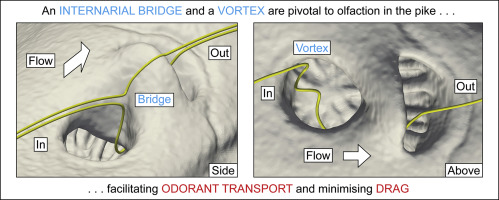当前位置:
X-MOL 学术
›
Comp. Biochem. Physiol. A Mol. Integr. Physiol.
›
论文详情
Our official English website, www.x-mol.net, welcomes your
feedback! (Note: you will need to create a separate account there.)
The functional nasal anatomy of the pike, Esox lucius L.
Comparative Biochemistry and Physiology A: Molecular & Integrative Physiology ( IF 2.1 ) Pub Date : 2020-03-22 , DOI: 10.1016/j.cbpa.2020.110688 Russell J Garwood 1 , Julia Behnsen 2 , Andrew T Ramsey 3 , Harriet K Haysom 4 , Luke J Dalby 5 , Samuel K Quilter 5 , James S Maclaine 6 , Zhijin Wang 7 , Jonathan P L Cox 4
Comparative Biochemistry and Physiology A: Molecular & Integrative Physiology ( IF 2.1 ) Pub Date : 2020-03-22 , DOI: 10.1016/j.cbpa.2020.110688 Russell J Garwood 1 , Julia Behnsen 2 , Andrew T Ramsey 3 , Harriet K Haysom 4 , Luke J Dalby 5 , Samuel K Quilter 5 , James S Maclaine 6 , Zhijin Wang 7 , Jonathan P L Cox 4
Affiliation

|
Olfactory flow in fishes is a little-explored area of fundamental and applied importance. We investigated olfactory flow in the pike, Esox lucius, because it has an apparently simple and rigid nasal region. We characterised olfactory flow by dye visualisation and computational fluid dynamics, using models derived from X-ray micro-computed tomography scans of two preserved specimens. An external current induced a flow of water through the nasal chamber at physiologically relevant Reynolds numbers (200-300). We attribute this externally-induced flow to: the location of the incurrent nostril in a region of high static pressure; the nasal bridge deflecting external flow into the nasal chamber; an excurrent nostril normal to external flow; and viscous entrainment. A vortex in the incurrent nostril may be instrumental in viscous entrainment. Flow was dispersed over the olfactory sensory surface when it impacted on the floor of the nasal chamber. Dispersal may be assisted by: the radial array of nasal folds; a complementary interaction between a posterior nasal fold and the ventral surface of the nasal bridge; and the incurrent vortex. The boundary layer could delay considerably (up to ~ 3 s) odorant transport from the external environment to the nasal region. The drag incurred by olfactory flow was almost the same as the drag incurred by models in which the nasal region had been replaced by a smooth surface. The boundary layer does not detach from the nasal region. We conclude that the nasal bridge and the incurrent vortex are pivotal to olfaction in the pike.
中文翻译:

梭子鱼Esox lucius L的功能性鼻部解剖。
鱼类中的嗅觉流动是一个尚未探索的具有根本和应用重要性的领域。我们调查了梭子鱼Esox lucius中的嗅觉流,因为它具有明显简单而刚性的鼻腔区域。我们使用两个可视化的样本的X射线微计算机断层扫描得出的模型,通过染料可视化和计算流体动力学来表征嗅觉流动。外部电流以生理上相关的雷诺数(200-300)诱导水流过鼻腔。我们将此外在流动归因于:高静压区域中的当前鼻孔的位置;鼻桥将外部流偏转到鼻腔中;正常流向外部的鼻孔;和粘性夹带。内流鼻孔中的涡旋可能有助于粘性夹带。当流撞击到鼻腔的地板上时,流散布在嗅觉感觉表面上。可以通过以下方式辅助弥散:鼻褶的放射状排列;鼻后褶和鼻梁腹面之间的互补相互作用;以及涡流。边界层可能会大大延迟(最多约3 s)气味剂从外部环境到鼻腔的运输。嗅觉流引起的阻力与鼻部区域被光滑表面代替的模型引起的阻力几乎相同。边界层不从鼻部分离。我们得出的结论是,鼻梁和内旋涡对梭子鱼的嗅觉至关重要。鼻褶的放射状排列;鼻后褶和鼻梁腹面之间的互补相互作用;以及涡流。边界层可能会大大延迟(最多约3 s)气味剂从外部环境到鼻腔的运输。嗅觉流引起的阻力与鼻部区域被光滑表面代替的模型引起的阻力几乎相同。边界层不从鼻部分离。我们得出的结论是,鼻梁和内旋涡对梭子鱼的嗅觉至关重要。鼻褶的放射状排列;鼻后褶和鼻梁腹面之间的互补相互作用;以及涡流。边界层可能会大大延迟(最多约3 s)气味剂从外部环境到鼻腔的运输。嗅觉流引起的阻力与鼻部区域被光滑表面代替的模型引起的阻力几乎相同。边界层不从鼻部分离。我们得出的结论是,鼻梁和内旋涡对梭子鱼的嗅觉至关重要。边界层可能会大大延迟(最多约3 s)气味剂从外部环境到鼻腔的运输。嗅觉流引起的阻力与鼻部区域被光滑表面代替的模型引起的阻力几乎相同。边界层不从鼻部分离。我们得出的结论是,鼻梁和内旋涡对梭子鱼的嗅觉至关重要。边界层可能会大大延迟(最多约3 s)气味剂从外部环境到鼻腔的运输。嗅觉流引起的阻力与鼻部区域被光滑表面代替的模型引起的阻力几乎相同。边界层不从鼻部分离。我们得出的结论是,鼻梁和内旋涡对梭子鱼的嗅觉至关重要。
更新日期:2020-03-22
中文翻译:

梭子鱼Esox lucius L的功能性鼻部解剖。
鱼类中的嗅觉流动是一个尚未探索的具有根本和应用重要性的领域。我们调查了梭子鱼Esox lucius中的嗅觉流,因为它具有明显简单而刚性的鼻腔区域。我们使用两个可视化的样本的X射线微计算机断层扫描得出的模型,通过染料可视化和计算流体动力学来表征嗅觉流动。外部电流以生理上相关的雷诺数(200-300)诱导水流过鼻腔。我们将此外在流动归因于:高静压区域中的当前鼻孔的位置;鼻桥将外部流偏转到鼻腔中;正常流向外部的鼻孔;和粘性夹带。内流鼻孔中的涡旋可能有助于粘性夹带。当流撞击到鼻腔的地板上时,流散布在嗅觉感觉表面上。可以通过以下方式辅助弥散:鼻褶的放射状排列;鼻后褶和鼻梁腹面之间的互补相互作用;以及涡流。边界层可能会大大延迟(最多约3 s)气味剂从外部环境到鼻腔的运输。嗅觉流引起的阻力与鼻部区域被光滑表面代替的模型引起的阻力几乎相同。边界层不从鼻部分离。我们得出的结论是,鼻梁和内旋涡对梭子鱼的嗅觉至关重要。鼻褶的放射状排列;鼻后褶和鼻梁腹面之间的互补相互作用;以及涡流。边界层可能会大大延迟(最多约3 s)气味剂从外部环境到鼻腔的运输。嗅觉流引起的阻力与鼻部区域被光滑表面代替的模型引起的阻力几乎相同。边界层不从鼻部分离。我们得出的结论是,鼻梁和内旋涡对梭子鱼的嗅觉至关重要。鼻褶的放射状排列;鼻后褶和鼻梁腹面之间的互补相互作用;以及涡流。边界层可能会大大延迟(最多约3 s)气味剂从外部环境到鼻腔的运输。嗅觉流引起的阻力与鼻部区域被光滑表面代替的模型引起的阻力几乎相同。边界层不从鼻部分离。我们得出的结论是,鼻梁和内旋涡对梭子鱼的嗅觉至关重要。边界层可能会大大延迟(最多约3 s)气味剂从外部环境到鼻腔的运输。嗅觉流引起的阻力与鼻部区域被光滑表面代替的模型引起的阻力几乎相同。边界层不从鼻部分离。我们得出的结论是,鼻梁和内旋涡对梭子鱼的嗅觉至关重要。边界层可能会大大延迟(最多约3 s)气味剂从外部环境到鼻腔的运输。嗅觉流引起的阻力与鼻部区域被光滑表面代替的模型引起的阻力几乎相同。边界层不从鼻部分离。我们得出的结论是,鼻梁和内旋涡对梭子鱼的嗅觉至关重要。











































 京公网安备 11010802027423号
京公网安备 11010802027423号